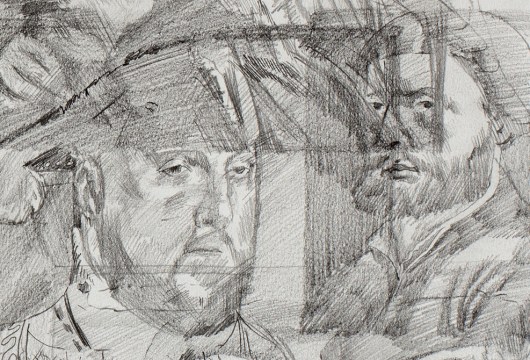
Across the Trees: Romanian Art Now
February 23- April 21, 2007
Across the Trees: Romanian Art Now
February 23- April 21, 2007
Across the Trees: Romanian Art Now
February 23- April 21, 2007
David Nolan Gallery is delighted to present Across the Trees: Romanian Art Now, an exhibition featuring the work of six young artists from Cluj, reputed one of today's most compelling centers of emerging art.* Adrian Ghenie, Ciprian Mureşan, Cristi Pogăcean, Serban Savu, Miklos Szilard and Gabriela Vanga represent a unique generation that occupies a fascinating position in Europe. While their childhoods were rooted in communism, their adolescences were spent witnessing the disintegration of the former regime and the introduction of the capitalist ideology. Having come of age during this uncertain, political flux, their works are infused what has been described by critics as "a certain immunity to Utopia." Exploring the ideologies, political systems and expectations that constrain the individual, the exhibition is a bittersweet realization of how each human being is responsible for change in our world.
Adrian Ghenie's dark and filmic paintings draw inspiration from history, notably the last 60 years of European history. Many of Ghenie's recent works depict people, objects and landscapes that look as if they've been coated by a strange, grey dust. Ghenie himself draws a metaphorical parallel between the ash that covered Pompeii following the eruption of Vesuvius in 79 AD and what happened to Eastern Europe during communism. The vibrant Eastern Europe remains, but hidden under an 'ideological dust'. Though thought-provoking, even disturbing at times, Ghenie's work is delivered in a lively, painterly style that suggests both life and activity can be found in even the darkest recesses.
Ciprian Mureşan works with video, object, drawing, painting and animation. His work is driven by social issues concerning the Romanian transition and he often uses highly visible contemporary sources to engage and re-engage with ideas and works that have made a considerable impact on art history. Much of Mureşan's practice involves the subversion of the viewer's preconditioned expectations and is interwoven by a gentle, often ironic sense of humour. While easy to digest at first, his work reveals an acute awareness of the human condition, the ever-present potential for the abuse of power and a latent threat of violence.
Cristi Pogăcean adopts a strongly conceptual approach to art-making. Laden with meaning and association born from the paradox of a studied, close engagement with his surrounding environs and its inhabitants, his works observe situations from a removed, almost scientific perspective. Pogăcean's practice can be divided into three areas: Firstly, a great deal of his work bears witness to collisions between the norms of social behaviour and an adherence to age-old belief systems. Secondly, much of his practice can be regarded as an investigation into the balance of power as encountered in the relationship between teacher and student or artist and curator. Thirdly, in the sculptural and installation aspects of his practice, Pogăcean demonstrates how our encounters with sole, small objects might enable us to receive a sense of something profound, abstract or expansive.
Serban Savu's poignant observations of 'ordinary' Romanians going about their business offer a subtle insight into how political change and economic growth in Romania is beginning to affect people's lives. His delicately rendered paintings are documents of characters that could be said to reflect common attitudes and the working practices of everyday life. Savu's commitment to observing the isolated 'Everyman' at work or at leisure in a rapidly developing Romania echoes Edward Hopper's fascination for what was happening to the so–called 'small-town' individual in America during the early to mid 20th Century. The small worlds Savu creates feel complete and convincing. Thorough and unsentimental, his gentle approach imbues the sense that the protagonists within his paintings are preserved, and somehow protected from the searching gaze of the inquisitive outsider.
Though thoroughly conceptual, Miklos Szilard's practice bears traces of Dada and Surrealist influence. In his hands, absurdity becomes a tool to seduce the viewer into returning to childhood games, or to enable the confrontation of awkward or difficult subjects. Szilard's work is a constant source of surprise, nothing is ever quite what it seems and he appears to delight in subtly modifying the most familiar objects in order to simultaneously enthrall and repel us.
A gentle playfulness accompanies much of Gabriela Vanga's practice which incorporates video, installation and objects. She toys and experiments with the manipulation of key ingredients. For example, by rearranging key letters in a word, Vanga weights down an otherwise stable equation; by erasing a partner in a pair of protagonists, Vanga removes the essence of the remaining being. This consequential blurring of perceived notions encourages the viewer to think again, to never accept anything as 'given' and to question everything for themselves. Her work often involves the actual as well as the intellectual participation of the viewer, and can even be physically demanding, requiring the viewer to move along, behind and round a particular piece of work or to 'join in' a performance.
* 'Across the Trees' is the literal translation of 'Transylvania'
This exhibition is organized in collaboration with Plan B Gallery, Cluj, with generous support from The Romanian Cultural Institute in New York.
